NURBN 2012: Case Study Analysis of Coronary Disease and Treatment
VerifiedAdded on 2023/01/19
|14
|3330
|25
Report
AI Summary
This report presents a comprehensive case study analysis of a patient, Betsy, diagnosed with coronary disease, angina, and other comorbidities. The report begins with an introduction that explains the rationale for performing an ECG on the patient. It then delves into the pathophysiology of angina, discussing the underlying mechanisms and risk factors, including hypertension and type 2 diabetes mellitus. The report includes an interpretation of Betsy's ECG, identifying key findings indicative of an inferior wall myocardial infarction. It also highlights the clinical criteria used to diagnose acute coronary syndromes. Furthermore, the report explores the mechanisms of action, side effects, and nursing considerations for various medications, including GTN, Pravastatin, and Diltiazem. It examines the roles of aspirin, ticagrelor, and morphine in managing cardiac patients, discussing their mechanisms and clinical applications. Finally, the report touches upon the relationship between chronic illness and the increased risk of depression, concluding with a summary of the key findings and their implications for patient care.
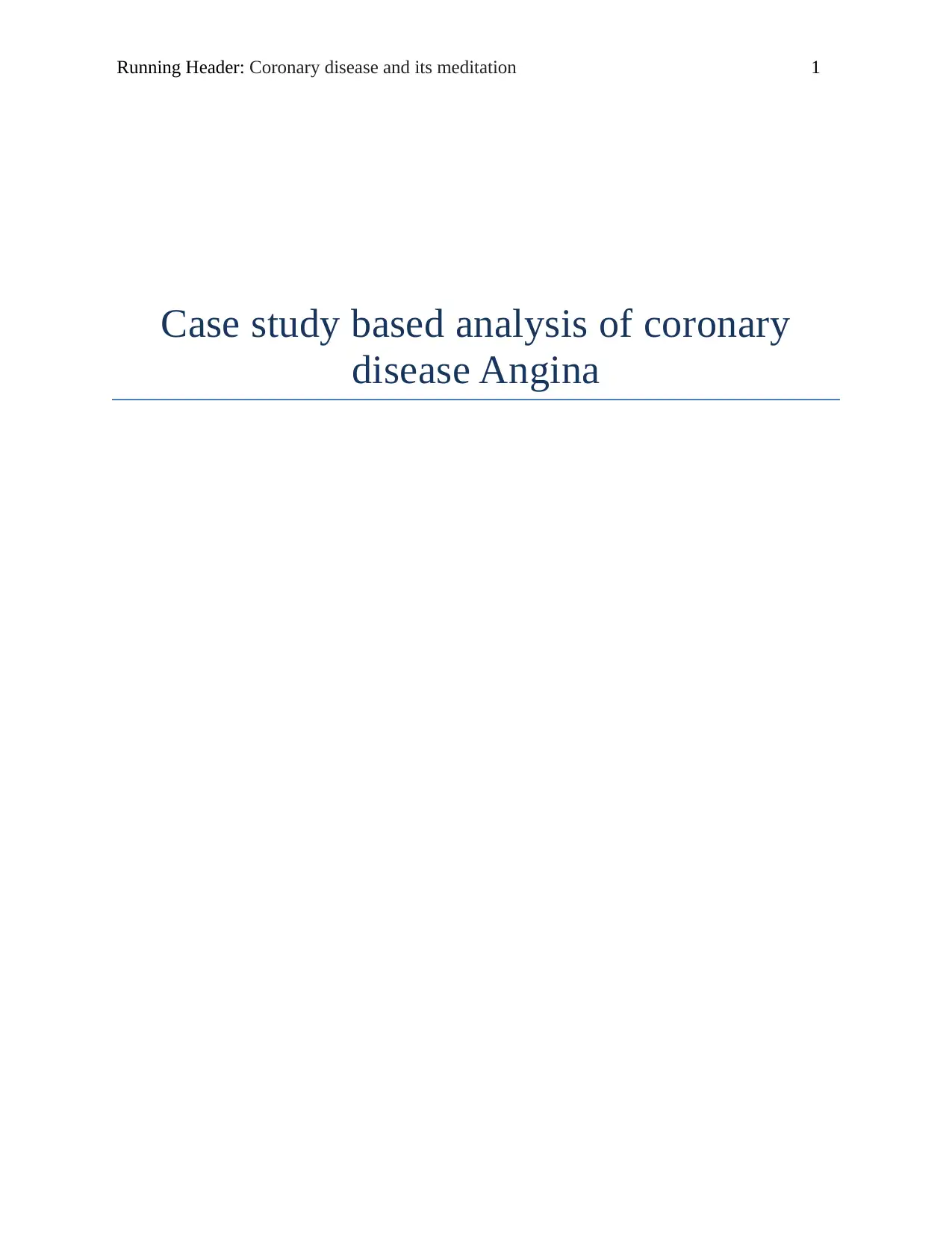
Running Header: Coronary disease and its meditation 1
Case study based analysis of coronary
disease Angina
Case study based analysis of coronary
disease Angina
Paraphrase This Document
Need a fresh take? Get an instant paraphrase of this document with our AI Paraphraser
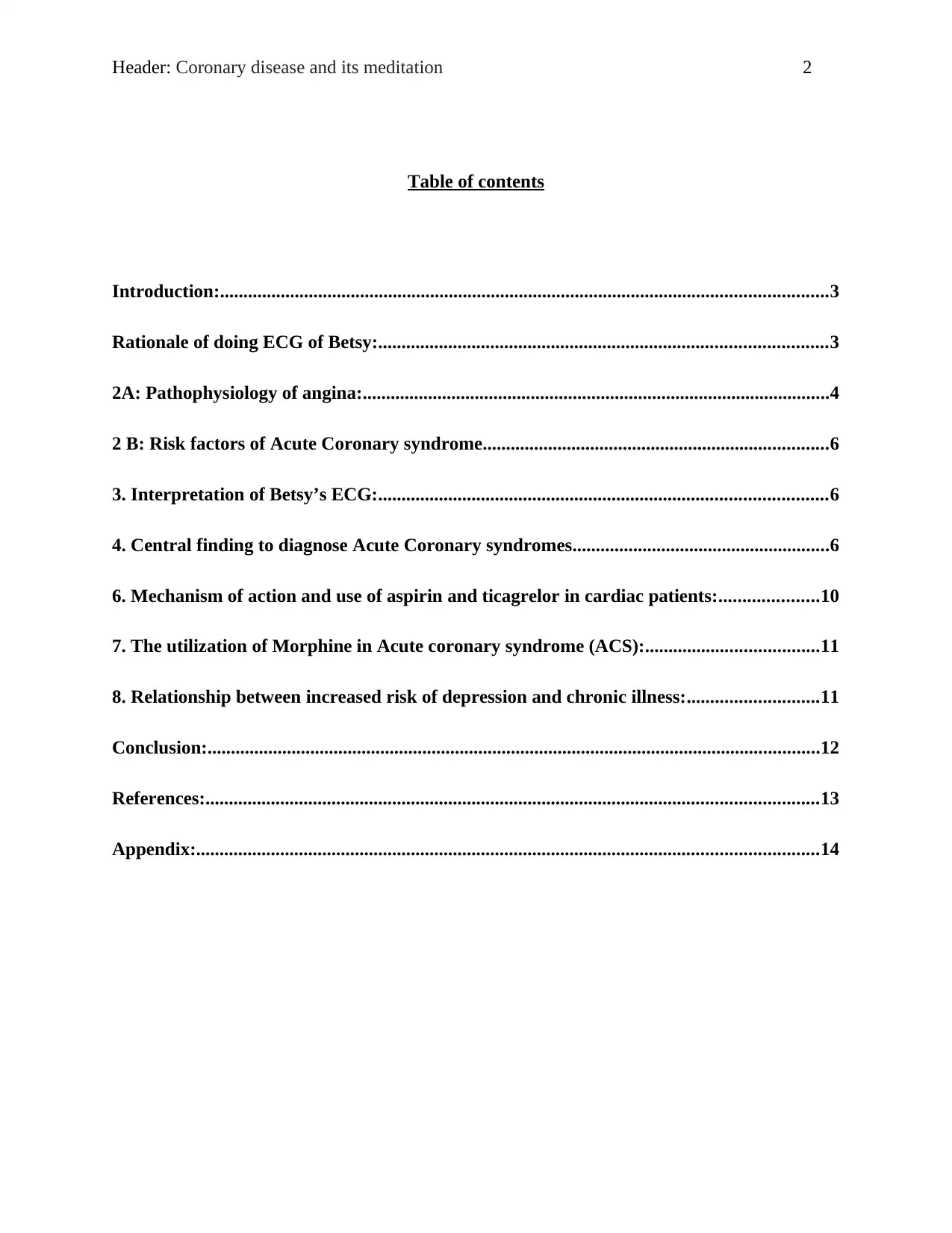
Header: Coronary disease and its meditation 2
Table of contents
Introduction:..................................................................................................................................3
Rationale of doing ECG of Betsy:................................................................................................3
2A: Pathophysiology of angina:....................................................................................................4
2 B: Risk factors of Acute Coronary syndrome..........................................................................6
3. Interpretation of Betsy’s ECG:................................................................................................6
4. Central finding to diagnose Acute Coronary syndromes.......................................................6
6. Mechanism of action and use of aspirin and ticagrelor in cardiac patients:.....................10
7. The utilization of Morphine in Acute coronary syndrome (ACS):.....................................11
8. Relationship between increased risk of depression and chronic illness:............................11
Conclusion:...................................................................................................................................12
References:...................................................................................................................................13
Appendix:.....................................................................................................................................14
Table of contents
Introduction:..................................................................................................................................3
Rationale of doing ECG of Betsy:................................................................................................3
2A: Pathophysiology of angina:....................................................................................................4
2 B: Risk factors of Acute Coronary syndrome..........................................................................6
3. Interpretation of Betsy’s ECG:................................................................................................6
4. Central finding to diagnose Acute Coronary syndromes.......................................................6
6. Mechanism of action and use of aspirin and ticagrelor in cardiac patients:.....................10
7. The utilization of Morphine in Acute coronary syndrome (ACS):.....................................11
8. Relationship between increased risk of depression and chronic illness:............................11
Conclusion:...................................................................................................................................12
References:...................................................................................................................................13
Appendix:.....................................................................................................................................14
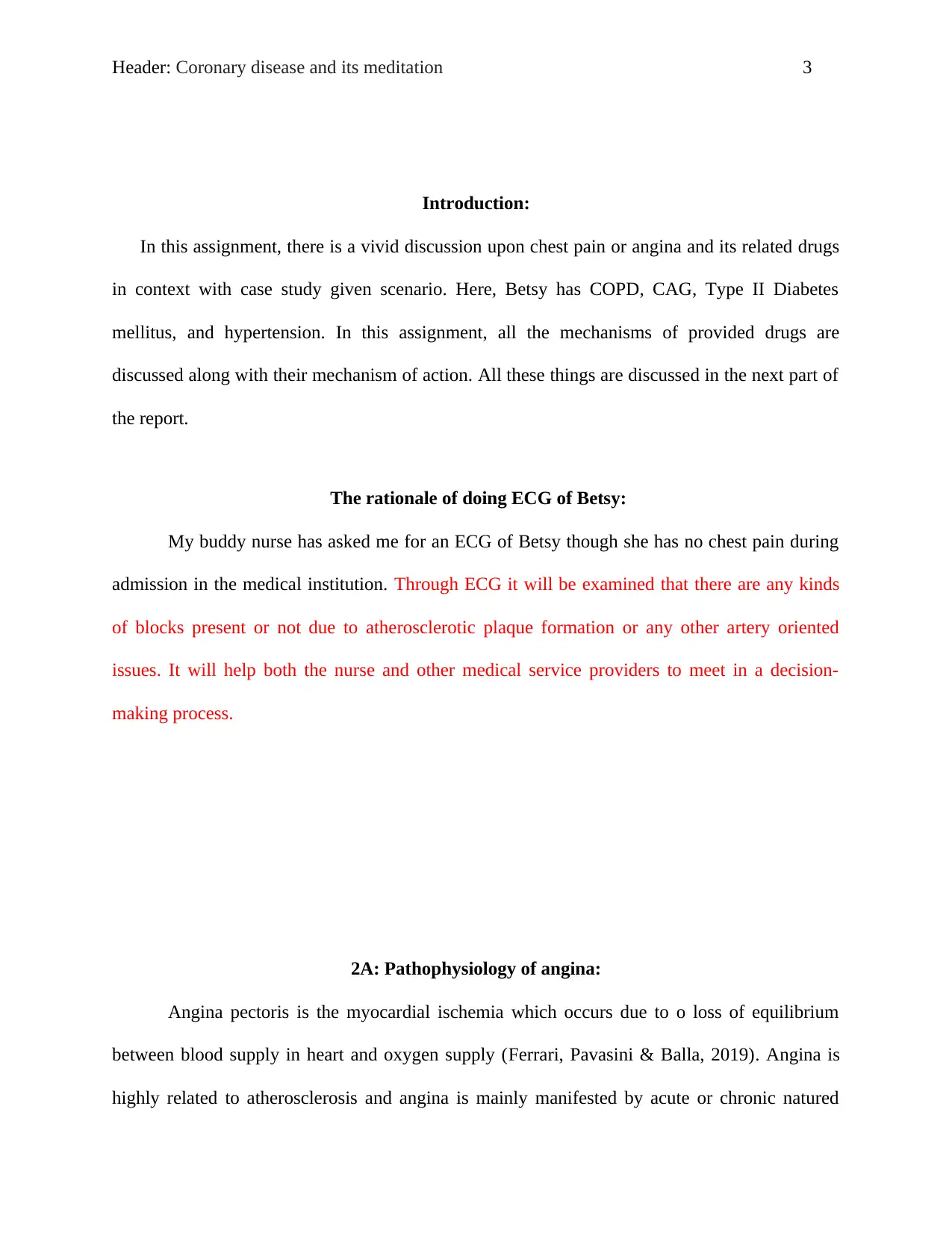
Header: Coronary disease and its meditation 3
Introduction:
In this assignment, there is a vivid discussion upon chest pain or angina and its related drugs
in context with case study given scenario. Here, Betsy has COPD, CAG, Type II Diabetes
mellitus, and hypertension. In this assignment, all the mechanisms of provided drugs are
discussed along with their mechanism of action. All these things are discussed in the next part of
the report.
The rationale of doing ECG of Betsy:
My buddy nurse has asked me for an ECG of Betsy though she has no chest pain during
admission in the medical institution. Through ECG it will be examined that there are any kinds
of blocks present or not due to atherosclerotic plaque formation or any other artery oriented
issues. It will help both the nurse and other medical service providers to meet in a decision-
making process.
2A: Pathophysiology of angina:
Angina pectoris is the myocardial ischemia which occurs due to o loss of equilibrium
between blood supply in heart and oxygen supply (Ferrari, Pavasini & Balla, 2019). Angina is
highly related to atherosclerosis and angina is mainly manifested by acute or chronic natured
Introduction:
In this assignment, there is a vivid discussion upon chest pain or angina and its related drugs
in context with case study given scenario. Here, Betsy has COPD, CAG, Type II Diabetes
mellitus, and hypertension. In this assignment, all the mechanisms of provided drugs are
discussed along with their mechanism of action. All these things are discussed in the next part of
the report.
The rationale of doing ECG of Betsy:
My buddy nurse has asked me for an ECG of Betsy though she has no chest pain during
admission in the medical institution. Through ECG it will be examined that there are any kinds
of blocks present or not due to atherosclerotic plaque formation or any other artery oriented
issues. It will help both the nurse and other medical service providers to meet in a decision-
making process.
2A: Pathophysiology of angina:
Angina pectoris is the myocardial ischemia which occurs due to o loss of equilibrium
between blood supply in heart and oxygen supply (Ferrari, Pavasini & Balla, 2019). Angina is
highly related to atherosclerosis and angina is mainly manifested by acute or chronic natured
⊘ This is a preview!⊘
Do you want full access?
Subscribe today to unlock all pages.

Trusted by 1+ million students worldwide
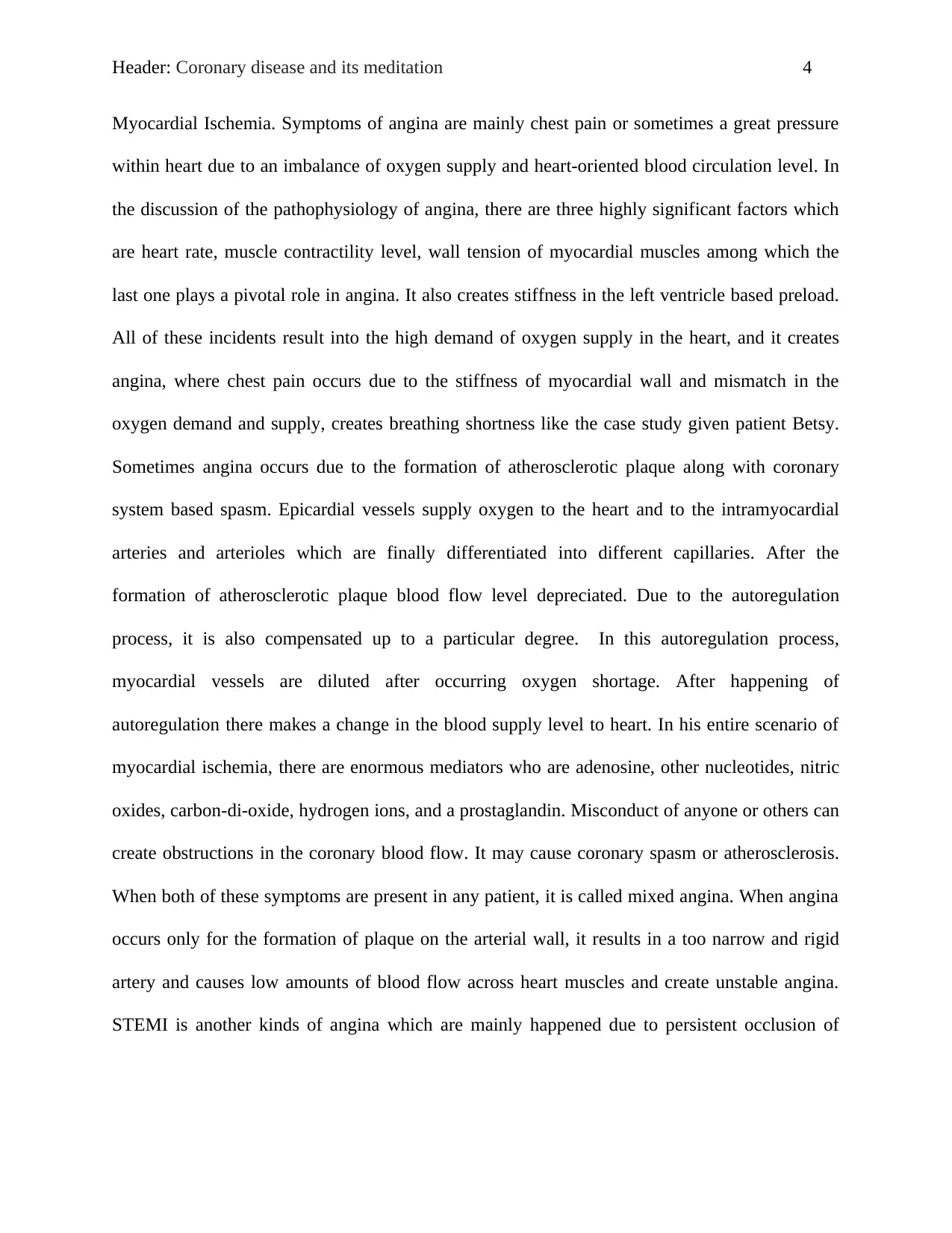
Header: Coronary disease and its meditation 4
Myocardial Ischemia. Symptoms of angina are mainly chest pain or sometimes a great pressure
within heart due to an imbalance of oxygen supply and heart-oriented blood circulation level. In
the discussion of the pathophysiology of angina, there are three highly significant factors which
are heart rate, muscle contractility level, wall tension of myocardial muscles among which the
last one plays a pivotal role in angina. It also creates stiffness in the left ventricle based preload.
All of these incidents result into the high demand of oxygen supply in the heart, and it creates
angina, where chest pain occurs due to the stiffness of myocardial wall and mismatch in the
oxygen demand and supply, creates breathing shortness like the case study given patient Betsy.
Sometimes angina occurs due to the formation of atherosclerotic plaque along with coronary
system based spasm. Epicardial vessels supply oxygen to the heart and to the intramyocardial
arteries and arterioles which are finally differentiated into different capillaries. After the
formation of atherosclerotic plaque blood flow level depreciated. Due to the autoregulation
process, it is also compensated up to a particular degree. In this autoregulation process,
myocardial vessels are diluted after occurring oxygen shortage. After happening of
autoregulation there makes a change in the blood supply level to heart. In his entire scenario of
myocardial ischemia, there are enormous mediators who are adenosine, other nucleotides, nitric
oxides, carbon-di-oxide, hydrogen ions, and a prostaglandin. Misconduct of anyone or others can
create obstructions in the coronary blood flow. It may cause coronary spasm or atherosclerosis.
When both of these symptoms are present in any patient, it is called mixed angina. When angina
occurs only for the formation of plaque on the arterial wall, it results in a too narrow and rigid
artery and causes low amounts of blood flow across heart muscles and create unstable angina.
STEMI is another kinds of angina which are mainly happened due to persistent occlusion of
Myocardial Ischemia. Symptoms of angina are mainly chest pain or sometimes a great pressure
within heart due to an imbalance of oxygen supply and heart-oriented blood circulation level. In
the discussion of the pathophysiology of angina, there are three highly significant factors which
are heart rate, muscle contractility level, wall tension of myocardial muscles among which the
last one plays a pivotal role in angina. It also creates stiffness in the left ventricle based preload.
All of these incidents result into the high demand of oxygen supply in the heart, and it creates
angina, where chest pain occurs due to the stiffness of myocardial wall and mismatch in the
oxygen demand and supply, creates breathing shortness like the case study given patient Betsy.
Sometimes angina occurs due to the formation of atherosclerotic plaque along with coronary
system based spasm. Epicardial vessels supply oxygen to the heart and to the intramyocardial
arteries and arterioles which are finally differentiated into different capillaries. After the
formation of atherosclerotic plaque blood flow level depreciated. Due to the autoregulation
process, it is also compensated up to a particular degree. In this autoregulation process,
myocardial vessels are diluted after occurring oxygen shortage. After happening of
autoregulation there makes a change in the blood supply level to heart. In his entire scenario of
myocardial ischemia, there are enormous mediators who are adenosine, other nucleotides, nitric
oxides, carbon-di-oxide, hydrogen ions, and a prostaglandin. Misconduct of anyone or others can
create obstructions in the coronary blood flow. It may cause coronary spasm or atherosclerosis.
When both of these symptoms are present in any patient, it is called mixed angina. When angina
occurs only for the formation of plaque on the arterial wall, it results in a too narrow and rigid
artery and causes low amounts of blood flow across heart muscles and create unstable angina.
STEMI is another kinds of angina which are mainly happened due to persistent occlusion of
Paraphrase This Document
Need a fresh take? Get an instant paraphrase of this document with our AI Paraphraser
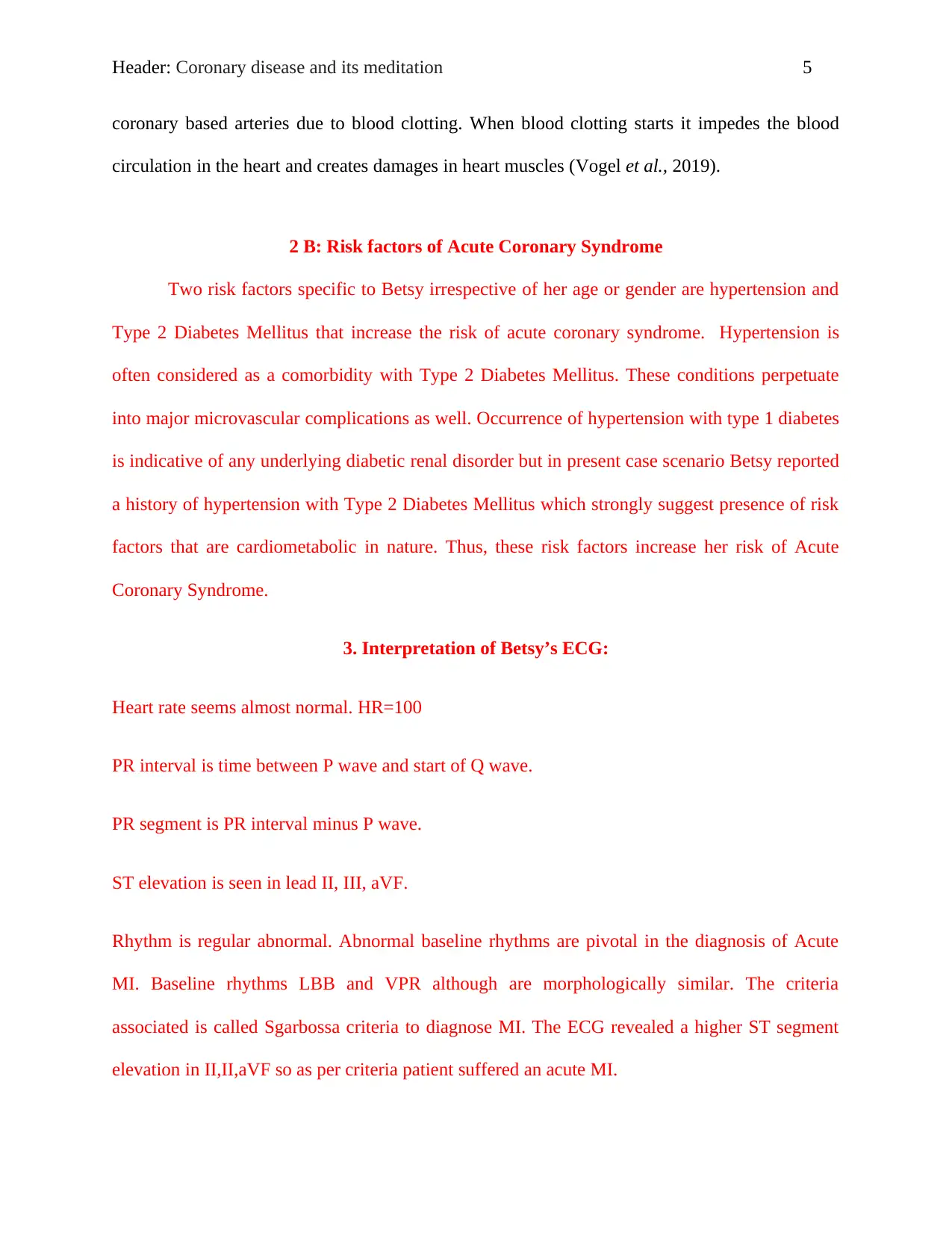
Header: Coronary disease and its meditation 5
coronary based arteries due to blood clotting. When blood clotting starts it impedes the blood
circulation in the heart and creates damages in heart muscles (Vogel et al., 2019).
2 B: Risk factors of Acute Coronary Syndrome
Two risk factors specific to Betsy irrespective of her age or gender are hypertension and
Type 2 Diabetes Mellitus that increase the risk of acute coronary syndrome. Hypertension is
often considered as a comorbidity with Type 2 Diabetes Mellitus. These conditions perpetuate
into major microvascular complications as well. Occurrence of hypertension with type 1 diabetes
is indicative of any underlying diabetic renal disorder but in present case scenario Betsy reported
a history of hypertension with Type 2 Diabetes Mellitus which strongly suggest presence of risk
factors that are cardiometabolic in nature. Thus, these risk factors increase her risk of Acute
Coronary Syndrome.
3. Interpretation of Betsy’s ECG:
Heart rate seems almost normal. HR=100
PR interval is time between P wave and start of Q wave.
PR segment is PR interval minus P wave.
ST elevation is seen in lead II, III, aVF.
Rhythm is regular abnormal. Abnormal baseline rhythms are pivotal in the diagnosis of Acute
MI. Baseline rhythms LBB and VPR although are morphologically similar. The criteria
associated is called Sgarbossa criteria to diagnose MI. The ECG revealed a higher ST segment
elevation in II,II,aVF so as per criteria patient suffered an acute MI.
coronary based arteries due to blood clotting. When blood clotting starts it impedes the blood
circulation in the heart and creates damages in heart muscles (Vogel et al., 2019).
2 B: Risk factors of Acute Coronary Syndrome
Two risk factors specific to Betsy irrespective of her age or gender are hypertension and
Type 2 Diabetes Mellitus that increase the risk of acute coronary syndrome. Hypertension is
often considered as a comorbidity with Type 2 Diabetes Mellitus. These conditions perpetuate
into major microvascular complications as well. Occurrence of hypertension with type 1 diabetes
is indicative of any underlying diabetic renal disorder but in present case scenario Betsy reported
a history of hypertension with Type 2 Diabetes Mellitus which strongly suggest presence of risk
factors that are cardiometabolic in nature. Thus, these risk factors increase her risk of Acute
Coronary Syndrome.
3. Interpretation of Betsy’s ECG:
Heart rate seems almost normal. HR=100
PR interval is time between P wave and start of Q wave.
PR segment is PR interval minus P wave.
ST elevation is seen in lead II, III, aVF.
Rhythm is regular abnormal. Abnormal baseline rhythms are pivotal in the diagnosis of Acute
MI. Baseline rhythms LBB and VPR although are morphologically similar. The criteria
associated is called Sgarbossa criteria to diagnose MI. The ECG revealed a higher ST segment
elevation in II,II,aVF so as per criteria patient suffered an acute MI.
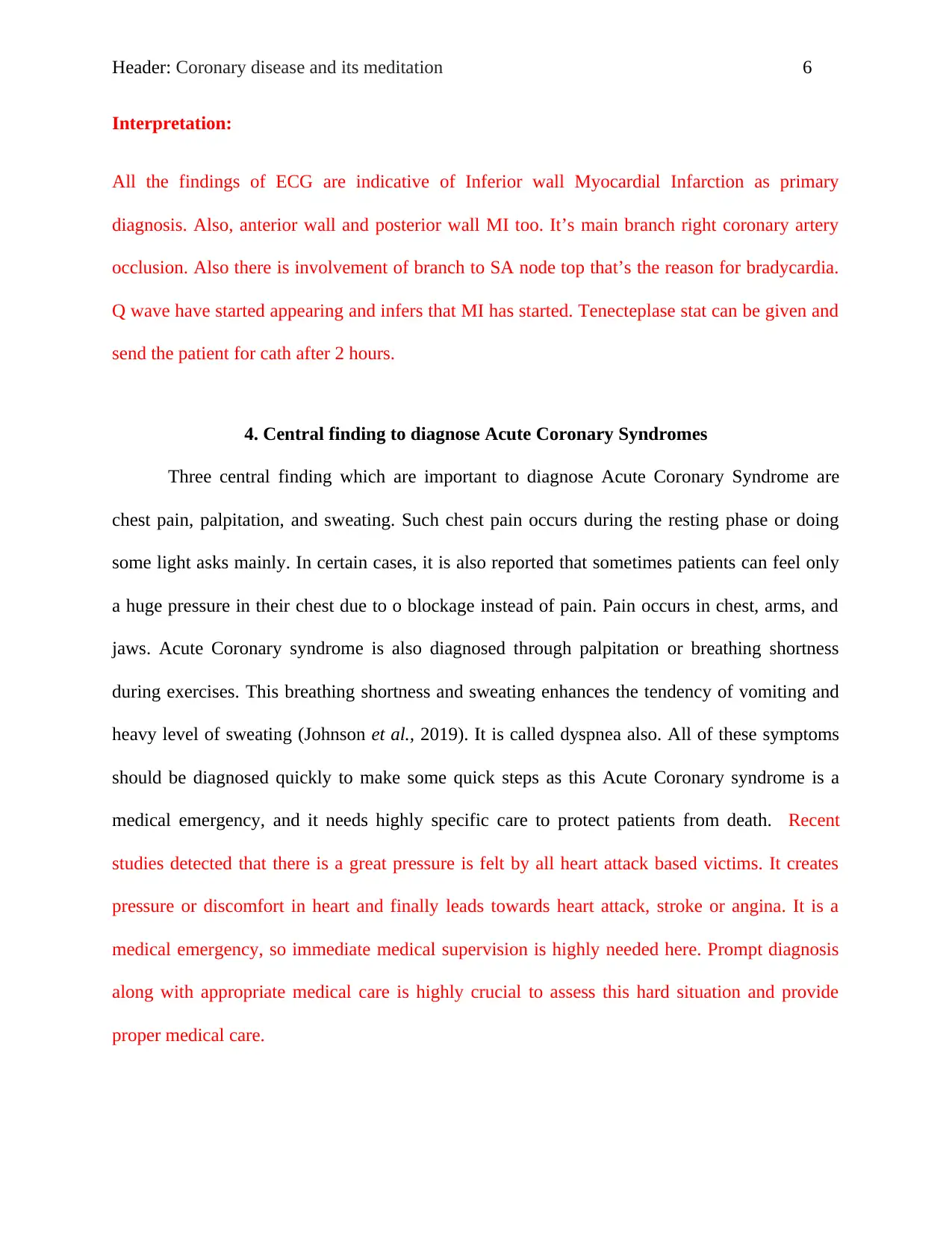
Header: Coronary disease and its meditation 6
Interpretation:
All the findings of ECG are indicative of Inferior wall Myocardial Infarction as primary
diagnosis. Also, anterior wall and posterior wall MI too. It’s main branch right coronary artery
occlusion. Also there is involvement of branch to SA node top that’s the reason for bradycardia.
Q wave have started appearing and infers that MI has started. Tenecteplase stat can be given and
send the patient for cath after 2 hours.
4. Central finding to diagnose Acute Coronary Syndromes
Three central finding which are important to diagnose Acute Coronary Syndrome are
chest pain, palpitation, and sweating. Such chest pain occurs during the resting phase or doing
some light asks mainly. In certain cases, it is also reported that sometimes patients can feel only
a huge pressure in their chest due to o blockage instead of pain. Pain occurs in chest, arms, and
jaws. Acute Coronary syndrome is also diagnosed through palpitation or breathing shortness
during exercises. This breathing shortness and sweating enhances the tendency of vomiting and
heavy level of sweating (Johnson et al., 2019). It is called dyspnea also. All of these symptoms
should be diagnosed quickly to make some quick steps as this Acute Coronary syndrome is a
medical emergency, and it needs highly specific care to protect patients from death. Recent
studies detected that there is a great pressure is felt by all heart attack based victims. It creates
pressure or discomfort in heart and finally leads towards heart attack, stroke or angina. It is a
medical emergency, so immediate medical supervision is highly needed here. Prompt diagnosis
along with appropriate medical care is highly crucial to assess this hard situation and provide
proper medical care.
Interpretation:
All the findings of ECG are indicative of Inferior wall Myocardial Infarction as primary
diagnosis. Also, anterior wall and posterior wall MI too. It’s main branch right coronary artery
occlusion. Also there is involvement of branch to SA node top that’s the reason for bradycardia.
Q wave have started appearing and infers that MI has started. Tenecteplase stat can be given and
send the patient for cath after 2 hours.
4. Central finding to diagnose Acute Coronary Syndromes
Three central finding which are important to diagnose Acute Coronary Syndrome are
chest pain, palpitation, and sweating. Such chest pain occurs during the resting phase or doing
some light asks mainly. In certain cases, it is also reported that sometimes patients can feel only
a huge pressure in their chest due to o blockage instead of pain. Pain occurs in chest, arms, and
jaws. Acute Coronary syndrome is also diagnosed through palpitation or breathing shortness
during exercises. This breathing shortness and sweating enhances the tendency of vomiting and
heavy level of sweating (Johnson et al., 2019). It is called dyspnea also. All of these symptoms
should be diagnosed quickly to make some quick steps as this Acute Coronary syndrome is a
medical emergency, and it needs highly specific care to protect patients from death. Recent
studies detected that there is a great pressure is felt by all heart attack based victims. It creates
pressure or discomfort in heart and finally leads towards heart attack, stroke or angina. It is a
medical emergency, so immediate medical supervision is highly needed here. Prompt diagnosis
along with appropriate medical care is highly crucial to assess this hard situation and provide
proper medical care.
⊘ This is a preview!⊘
Do you want full access?
Subscribe today to unlock all pages.

Trusted by 1+ million students worldwide
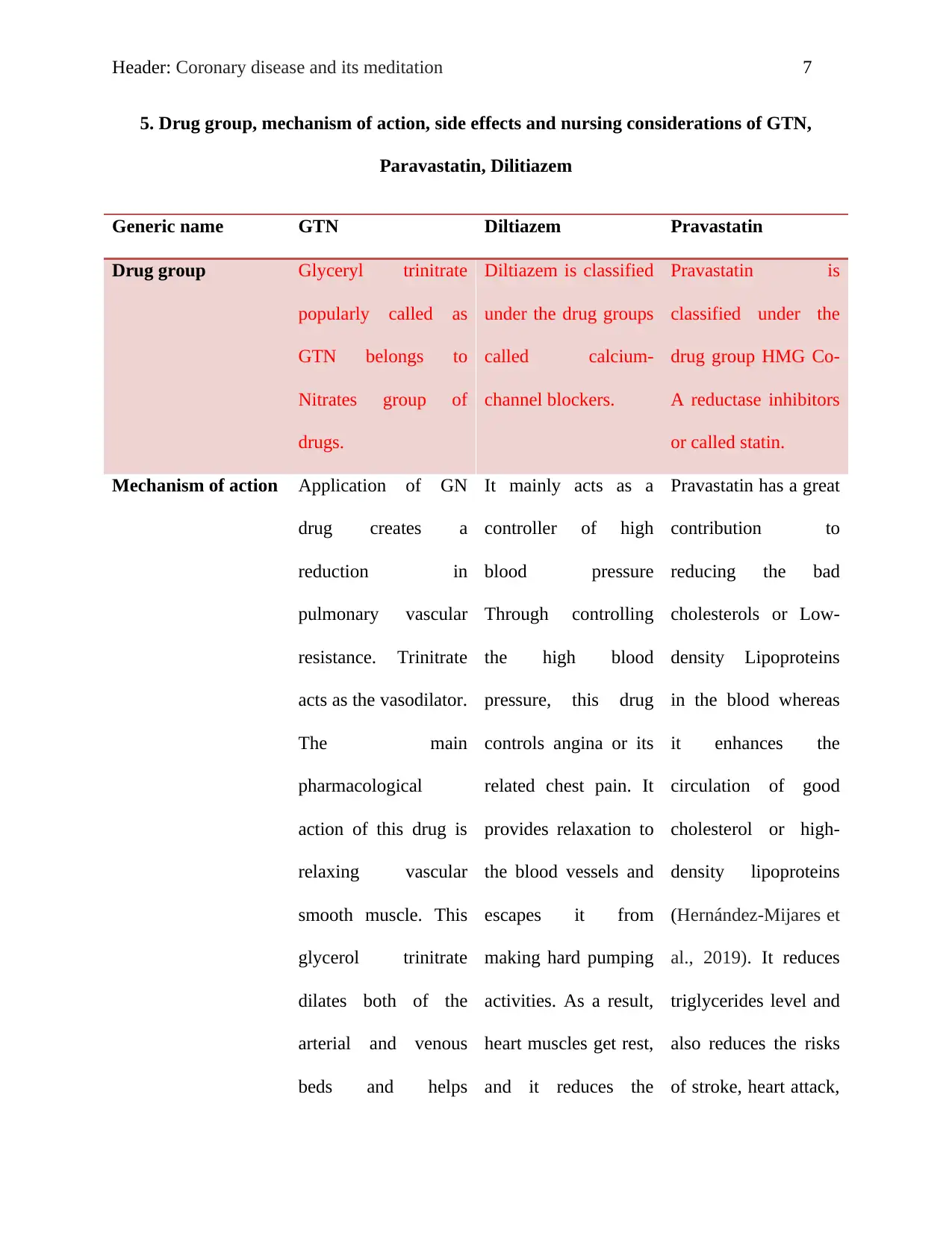
Header: Coronary disease and its meditation 7
5. Drug group, mechanism of action, side effects and nursing considerations of GTN,
Paravastatin, Dilitiazem
Generic name GTN Diltiazem Pravastatin
Drug group Glyceryl trinitrate
popularly called as
GTN belongs to
Nitrates group of
drugs.
Diltiazem is classified
under the drug groups
called calcium-
channel blockers.
Pravastatin is
classified under the
drug group HMG Co-
A reductase inhibitors
or called statin.
Mechanism of action Application of GN
drug creates a
reduction in
pulmonary vascular
resistance. Trinitrate
acts as the vasodilator.
The main
pharmacological
action of this drug is
relaxing vascular
smooth muscle. This
glycerol trinitrate
dilates both of the
arterial and venous
beds and helps
It mainly acts as a
controller of high
blood pressure
Through controlling
the high blood
pressure, this drug
controls angina or its
related chest pain. It
provides relaxation to
the blood vessels and
escapes it from
making hard pumping
activities. As a result,
heart muscles get rest,
and it reduces the
Pravastatin has a great
contribution to
reducing the bad
cholesterols or Low-
density Lipoproteins
in the blood whereas
it enhances the
circulation of good
cholesterol or high-
density lipoproteins
(Hernández-Mijares et
al., 2019). It reduces
triglycerides level and
also reduces the risks
of stroke, heart attack,
5. Drug group, mechanism of action, side effects and nursing considerations of GTN,
Paravastatin, Dilitiazem
Generic name GTN Diltiazem Pravastatin
Drug group Glyceryl trinitrate
popularly called as
GTN belongs to
Nitrates group of
drugs.
Diltiazem is classified
under the drug groups
called calcium-
channel blockers.
Pravastatin is
classified under the
drug group HMG Co-
A reductase inhibitors
or called statin.
Mechanism of action Application of GN
drug creates a
reduction in
pulmonary vascular
resistance. Trinitrate
acts as the vasodilator.
The main
pharmacological
action of this drug is
relaxing vascular
smooth muscle. This
glycerol trinitrate
dilates both of the
arterial and venous
beds and helps
It mainly acts as a
controller of high
blood pressure
Through controlling
the high blood
pressure, this drug
controls angina or its
related chest pain. It
provides relaxation to
the blood vessels and
escapes it from
making hard pumping
activities. As a result,
heart muscles get rest,
and it reduces the
Pravastatin has a great
contribution to
reducing the bad
cholesterols or Low-
density Lipoproteins
in the blood whereas
it enhances the
circulation of good
cholesterol or high-
density lipoproteins
(Hernández-Mijares et
al., 2019). It reduces
triglycerides level and
also reduces the risks
of stroke, heart attack,
Paraphrase This Document
Need a fresh take? Get an instant paraphrase of this document with our AI Paraphraser
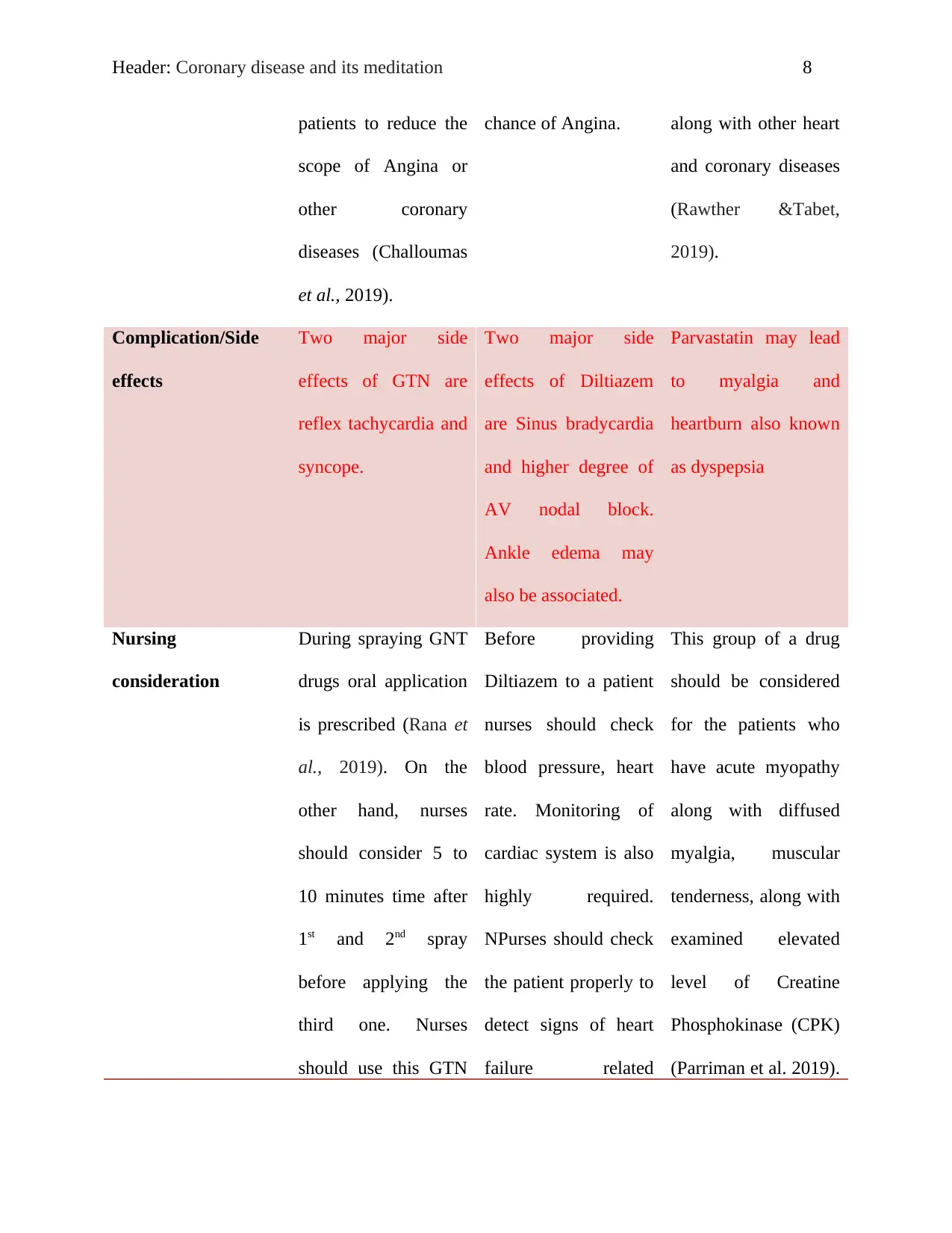
Header: Coronary disease and its meditation 8
patients to reduce the
scope of Angina or
other coronary
diseases (Challoumas
et al., 2019).
chance of Angina. along with other heart
and coronary diseases
(Rawther &Tabet,
2019).
Complication/Side
effects
Two major side
effects of GTN are
reflex tachycardia and
syncope.
Two major side
effects of Diltiazem
are Sinus bradycardia
and higher degree of
AV nodal block.
Ankle edema may
also be associated.
Parvastatin may lead
to myalgia and
heartburn also known
as dyspepsia
Nursing
consideration
During spraying GNT
drugs oral application
is prescribed (Rana et
al., 2019). On the
other hand, nurses
should consider 5 to
10 minutes time after
1st and 2nd spray
before applying the
third one. Nurses
should use this GTN
Before providing
Diltiazem to a patient
nurses should check
blood pressure, heart
rate. Monitoring of
cardiac system is also
highly required.
NPurses should check
the patient properly to
detect signs of heart
failure related
This group of a drug
should be considered
for the patients who
have acute myopathy
along with diffused
myalgia, muscular
tenderness, along with
examined elevated
level of Creatine
Phosphokinase (CPK)
(Parriman et al. 2019).
patients to reduce the
scope of Angina or
other coronary
diseases (Challoumas
et al., 2019).
chance of Angina. along with other heart
and coronary diseases
(Rawther &Tabet,
2019).
Complication/Side
effects
Two major side
effects of GTN are
reflex tachycardia and
syncope.
Two major side
effects of Diltiazem
are Sinus bradycardia
and higher degree of
AV nodal block.
Ankle edema may
also be associated.
Parvastatin may lead
to myalgia and
heartburn also known
as dyspepsia
Nursing
consideration
During spraying GNT
drugs oral application
is prescribed (Rana et
al., 2019). On the
other hand, nurses
should consider 5 to
10 minutes time after
1st and 2nd spray
before applying the
third one. Nurses
should use this GTN
Before providing
Diltiazem to a patient
nurses should check
blood pressure, heart
rate. Monitoring of
cardiac system is also
highly required.
NPurses should check
the patient properly to
detect signs of heart
failure related
This group of a drug
should be considered
for the patients who
have acute myopathy
along with diffused
myalgia, muscular
tenderness, along with
examined elevated
level of Creatine
Phosphokinase (CPK)
(Parriman et al. 2019).
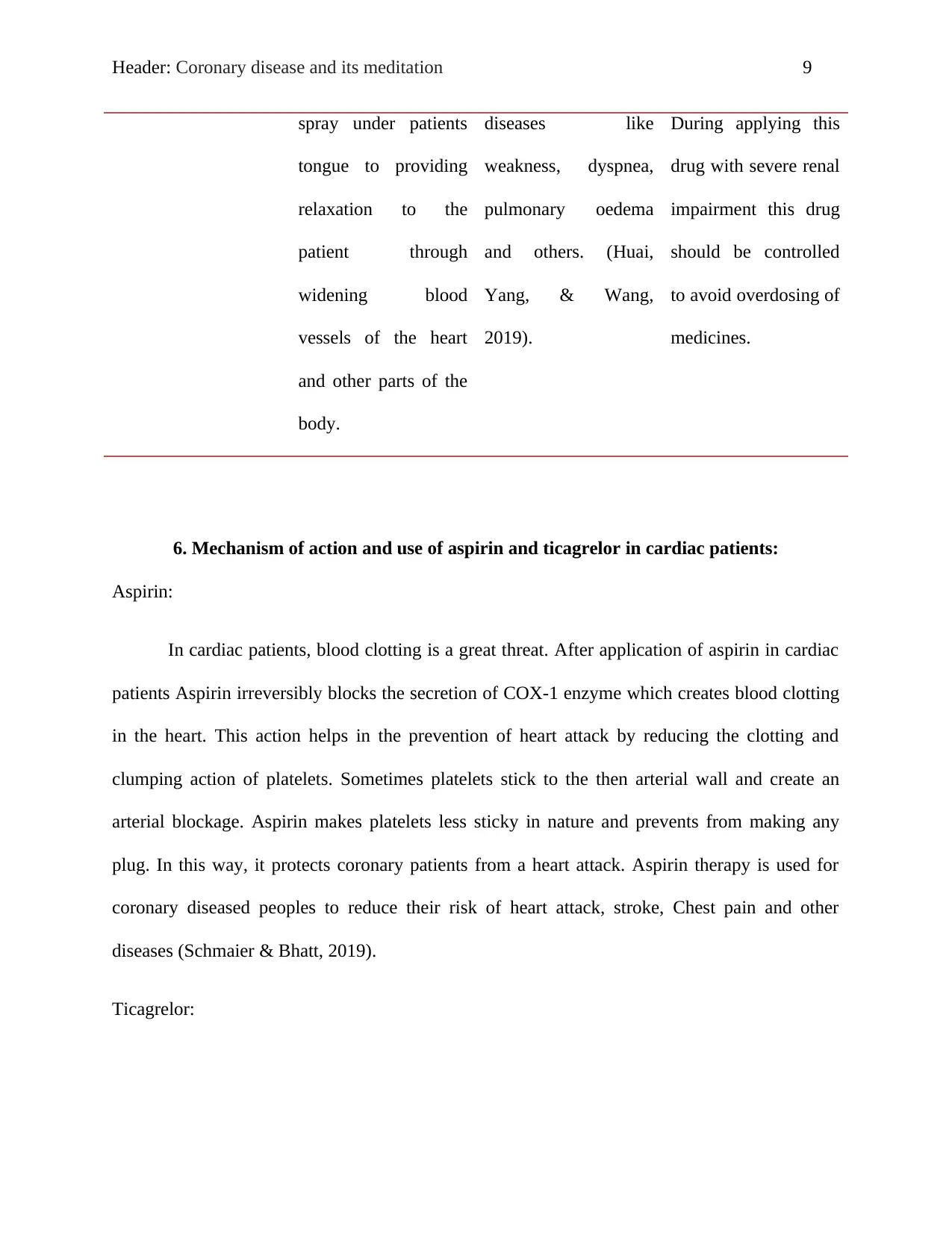
Header: Coronary disease and its meditation 9
spray under patients
tongue to providing
relaxation to the
patient through
widening blood
vessels of the heart
and other parts of the
body.
diseases like
weakness, dyspnea,
pulmonary oedema
and others. (Huai,
Yang, & Wang,
2019).
During applying this
drug with severe renal
impairment this drug
should be controlled
to avoid overdosing of
medicines.
6. Mechanism of action and use of aspirin and ticagrelor in cardiac patients:
Aspirin:
In cardiac patients, blood clotting is a great threat. After application of aspirin in cardiac
patients Aspirin irreversibly blocks the secretion of COX-1 enzyme which creates blood clotting
in the heart. This action helps in the prevention of heart attack by reducing the clotting and
clumping action of platelets. Sometimes platelets stick to the then arterial wall and create an
arterial blockage. Aspirin makes platelets less sticky in nature and prevents from making any
plug. In this way, it protects coronary patients from a heart attack. Aspirin therapy is used for
coronary diseased peoples to reduce their risk of heart attack, stroke, Chest pain and other
diseases (Schmaier & Bhatt, 2019).
Ticagrelor:
spray under patients
tongue to providing
relaxation to the
patient through
widening blood
vessels of the heart
and other parts of the
body.
diseases like
weakness, dyspnea,
pulmonary oedema
and others. (Huai,
Yang, & Wang,
2019).
During applying this
drug with severe renal
impairment this drug
should be controlled
to avoid overdosing of
medicines.
6. Mechanism of action and use of aspirin and ticagrelor in cardiac patients:
Aspirin:
In cardiac patients, blood clotting is a great threat. After application of aspirin in cardiac
patients Aspirin irreversibly blocks the secretion of COX-1 enzyme which creates blood clotting
in the heart. This action helps in the prevention of heart attack by reducing the clotting and
clumping action of platelets. Sometimes platelets stick to the then arterial wall and create an
arterial blockage. Aspirin makes platelets less sticky in nature and prevents from making any
plug. In this way, it protects coronary patients from a heart attack. Aspirin therapy is used for
coronary diseased peoples to reduce their risk of heart attack, stroke, Chest pain and other
diseases (Schmaier & Bhatt, 2019).
Ticagrelor:
⊘ This is a preview!⊘
Do you want full access?
Subscribe today to unlock all pages.

Trusted by 1+ million students worldwide
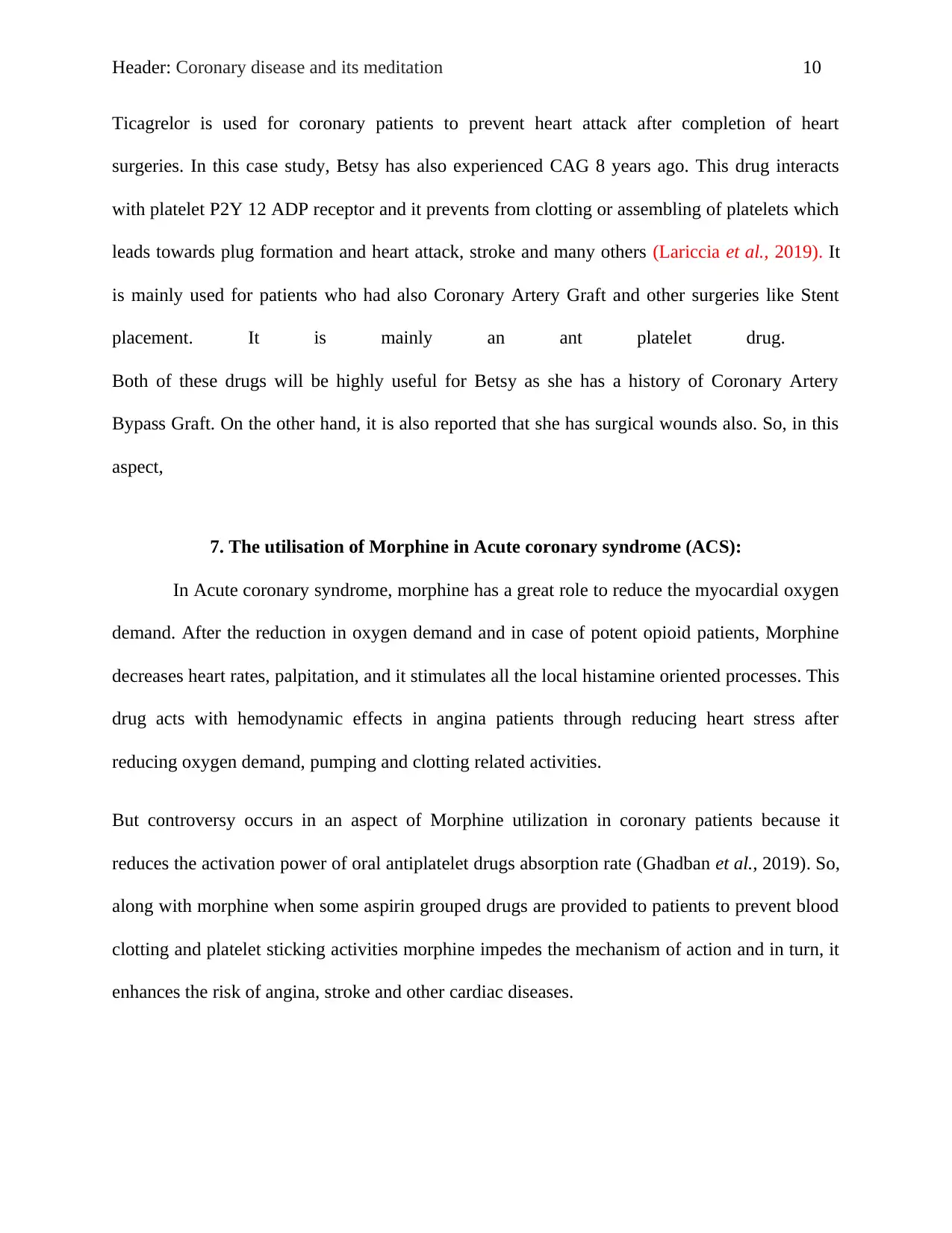
Header: Coronary disease and its meditation 10
Ticagrelor is used for coronary patients to prevent heart attack after completion of heart
surgeries. In this case study, Betsy has also experienced CAG 8 years ago. This drug interacts
with platelet P2Y 12 ADP receptor and it prevents from clotting or assembling of platelets which
leads towards plug formation and heart attack, stroke and many others (Lariccia et al., 2019). It
is mainly used for patients who had also Coronary Artery Graft and other surgeries like Stent
placement. It is mainly an ant platelet drug.
Both of these drugs will be highly useful for Betsy as she has a history of Coronary Artery
Bypass Graft. On the other hand, it is also reported that she has surgical wounds also. So, in this
aspect,
7. The utilisation of Morphine in Acute coronary syndrome (ACS):
In Acute coronary syndrome, morphine has a great role to reduce the myocardial oxygen
demand. After the reduction in oxygen demand and in case of potent opioid patients, Morphine
decreases heart rates, palpitation, and it stimulates all the local histamine oriented processes. This
drug acts with hemodynamic effects in angina patients through reducing heart stress after
reducing oxygen demand, pumping and clotting related activities.
But controversy occurs in an aspect of Morphine utilization in coronary patients because it
reduces the activation power of oral antiplatelet drugs absorption rate (Ghadban et al., 2019). So,
along with morphine when some aspirin grouped drugs are provided to patients to prevent blood
clotting and platelet sticking activities morphine impedes the mechanism of action and in turn, it
enhances the risk of angina, stroke and other cardiac diseases.
Ticagrelor is used for coronary patients to prevent heart attack after completion of heart
surgeries. In this case study, Betsy has also experienced CAG 8 years ago. This drug interacts
with platelet P2Y 12 ADP receptor and it prevents from clotting or assembling of platelets which
leads towards plug formation and heart attack, stroke and many others (Lariccia et al., 2019). It
is mainly used for patients who had also Coronary Artery Graft and other surgeries like Stent
placement. It is mainly an ant platelet drug.
Both of these drugs will be highly useful for Betsy as she has a history of Coronary Artery
Bypass Graft. On the other hand, it is also reported that she has surgical wounds also. So, in this
aspect,
7. The utilisation of Morphine in Acute coronary syndrome (ACS):
In Acute coronary syndrome, morphine has a great role to reduce the myocardial oxygen
demand. After the reduction in oxygen demand and in case of potent opioid patients, Morphine
decreases heart rates, palpitation, and it stimulates all the local histamine oriented processes. This
drug acts with hemodynamic effects in angina patients through reducing heart stress after
reducing oxygen demand, pumping and clotting related activities.
But controversy occurs in an aspect of Morphine utilization in coronary patients because it
reduces the activation power of oral antiplatelet drugs absorption rate (Ghadban et al., 2019). So,
along with morphine when some aspirin grouped drugs are provided to patients to prevent blood
clotting and platelet sticking activities morphine impedes the mechanism of action and in turn, it
enhances the risk of angina, stroke and other cardiac diseases.
Paraphrase This Document
Need a fresh take? Get an instant paraphrase of this document with our AI Paraphraser
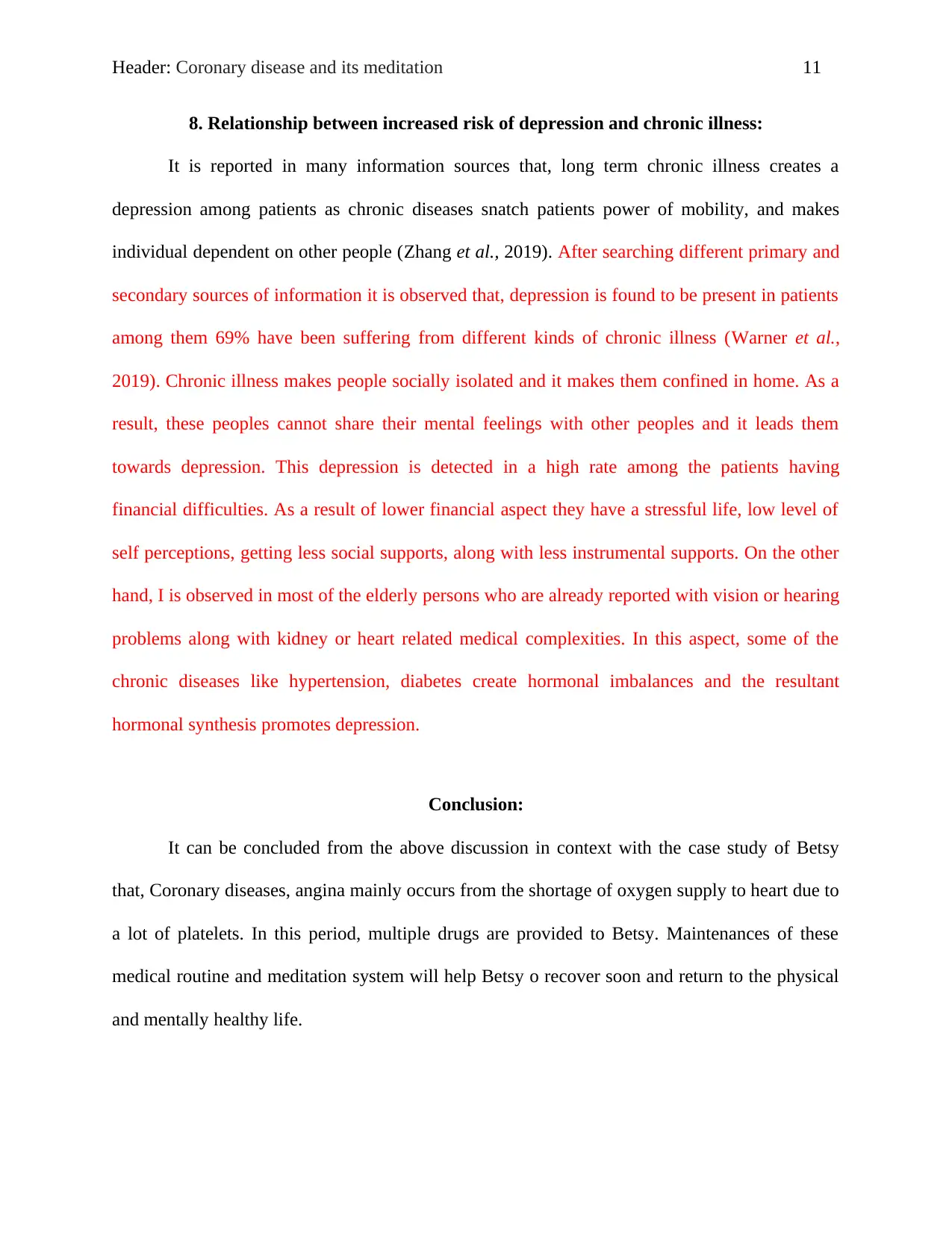
Header: Coronary disease and its meditation 11
8. Relationship between increased risk of depression and chronic illness:
It is reported in many information sources that, long term chronic illness creates a
depression among patients as chronic diseases snatch patients power of mobility, and makes
individual dependent on other people (Zhang et al., 2019). After searching different primary and
secondary sources of information it is observed that, depression is found to be present in patients
among them 69% have been suffering from different kinds of chronic illness (Warner et al.,
2019). Chronic illness makes people socially isolated and it makes them confined in home. As a
result, these peoples cannot share their mental feelings with other peoples and it leads them
towards depression. This depression is detected in a high rate among the patients having
financial difficulties. As a result of lower financial aspect they have a stressful life, low level of
self perceptions, getting less social supports, along with less instrumental supports. On the other
hand, I is observed in most of the elderly persons who are already reported with vision or hearing
problems along with kidney or heart related medical complexities. In this aspect, some of the
chronic diseases like hypertension, diabetes create hormonal imbalances and the resultant
hormonal synthesis promotes depression.
Conclusion:
It can be concluded from the above discussion in context with the case study of Betsy
that, Coronary diseases, angina mainly occurs from the shortage of oxygen supply to heart due to
a lot of platelets. In this period, multiple drugs are provided to Betsy. Maintenances of these
medical routine and meditation system will help Betsy o recover soon and return to the physical
and mentally healthy life.
8. Relationship between increased risk of depression and chronic illness:
It is reported in many information sources that, long term chronic illness creates a
depression among patients as chronic diseases snatch patients power of mobility, and makes
individual dependent on other people (Zhang et al., 2019). After searching different primary and
secondary sources of information it is observed that, depression is found to be present in patients
among them 69% have been suffering from different kinds of chronic illness (Warner et al.,
2019). Chronic illness makes people socially isolated and it makes them confined in home. As a
result, these peoples cannot share their mental feelings with other peoples and it leads them
towards depression. This depression is detected in a high rate among the patients having
financial difficulties. As a result of lower financial aspect they have a stressful life, low level of
self perceptions, getting less social supports, along with less instrumental supports. On the other
hand, I is observed in most of the elderly persons who are already reported with vision or hearing
problems along with kidney or heart related medical complexities. In this aspect, some of the
chronic diseases like hypertension, diabetes create hormonal imbalances and the resultant
hormonal synthesis promotes depression.
Conclusion:
It can be concluded from the above discussion in context with the case study of Betsy
that, Coronary diseases, angina mainly occurs from the shortage of oxygen supply to heart due to
a lot of platelets. In this period, multiple drugs are provided to Betsy. Maintenances of these
medical routine and meditation system will help Betsy o recover soon and return to the physical
and mentally healthy life.
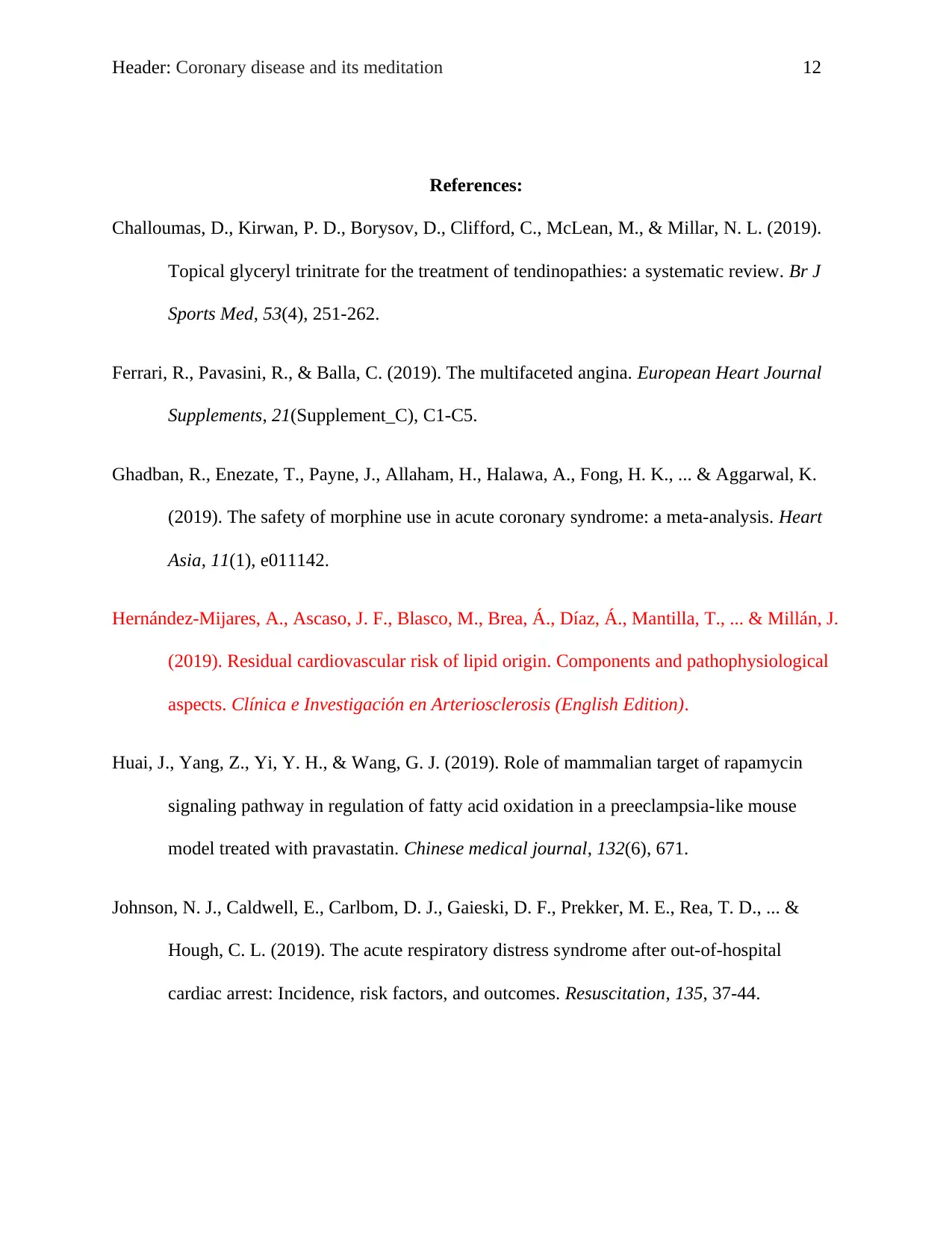
Header: Coronary disease and its meditation 12
References:
Challoumas, D., Kirwan, P. D., Borysov, D., Clifford, C., McLean, M., & Millar, N. L. (2019).
Topical glyceryl trinitrate for the treatment of tendinopathies: a systematic review. Br J
Sports Med, 53(4), 251-262.
Ferrari, R., Pavasini, R., & Balla, C. (2019). The multifaceted angina. European Heart Journal
Supplements, 21(Supplement_C), C1-C5.
Ghadban, R., Enezate, T., Payne, J., Allaham, H., Halawa, A., Fong, H. K., ... & Aggarwal, K.
(2019). The safety of morphine use in acute coronary syndrome: a meta-analysis. Heart
Asia, 11(1), e011142.
Hernández-Mijares, A., Ascaso, J. F., Blasco, M., Brea, Á., Díaz, Á., Mantilla, T., ... & Millán, J.
(2019). Residual cardiovascular risk of lipid origin. Components and pathophysiological
aspects. Clínica e Investigación en Arteriosclerosis (English Edition).
Huai, J., Yang, Z., Yi, Y. H., & Wang, G. J. (2019). Role of mammalian target of rapamycin
signaling pathway in regulation of fatty acid oxidation in a preeclampsia-like mouse
model treated with pravastatin. Chinese medical journal, 132(6), 671.
Johnson, N. J., Caldwell, E., Carlbom, D. J., Gaieski, D. F., Prekker, M. E., Rea, T. D., ... &
Hough, C. L. (2019). The acute respiratory distress syndrome after out-of-hospital
cardiac arrest: Incidence, risk factors, and outcomes. Resuscitation, 135, 37-44.
References:
Challoumas, D., Kirwan, P. D., Borysov, D., Clifford, C., McLean, M., & Millar, N. L. (2019).
Topical glyceryl trinitrate for the treatment of tendinopathies: a systematic review. Br J
Sports Med, 53(4), 251-262.
Ferrari, R., Pavasini, R., & Balla, C. (2019). The multifaceted angina. European Heart Journal
Supplements, 21(Supplement_C), C1-C5.
Ghadban, R., Enezate, T., Payne, J., Allaham, H., Halawa, A., Fong, H. K., ... & Aggarwal, K.
(2019). The safety of morphine use in acute coronary syndrome: a meta-analysis. Heart
Asia, 11(1), e011142.
Hernández-Mijares, A., Ascaso, J. F., Blasco, M., Brea, Á., Díaz, Á., Mantilla, T., ... & Millán, J.
(2019). Residual cardiovascular risk of lipid origin. Components and pathophysiological
aspects. Clínica e Investigación en Arteriosclerosis (English Edition).
Huai, J., Yang, Z., Yi, Y. H., & Wang, G. J. (2019). Role of mammalian target of rapamycin
signaling pathway in regulation of fatty acid oxidation in a preeclampsia-like mouse
model treated with pravastatin. Chinese medical journal, 132(6), 671.
Johnson, N. J., Caldwell, E., Carlbom, D. J., Gaieski, D. F., Prekker, M. E., Rea, T. D., ... &
Hough, C. L. (2019). The acute respiratory distress syndrome after out-of-hospital
cardiac arrest: Incidence, risk factors, and outcomes. Resuscitation, 135, 37-44.
⊘ This is a preview!⊘
Do you want full access?
Subscribe today to unlock all pages.

Trusted by 1+ million students worldwide
1 out of 14
Related Documents
Your All-in-One AI-Powered Toolkit for Academic Success.
+13062052269
info@desklib.com
Available 24*7 on WhatsApp / Email
![[object Object]](/_next/static/media/star-bottom.7253800d.svg)
Unlock your academic potential
Copyright © 2020–2025 A2Z Services. All Rights Reserved. Developed and managed by ZUCOL.





